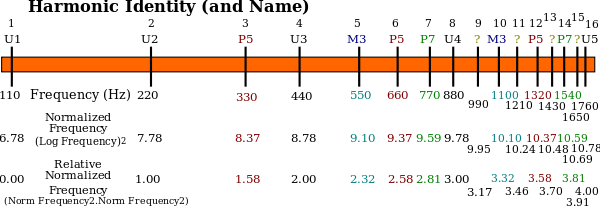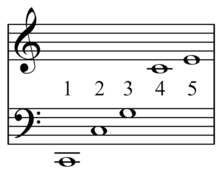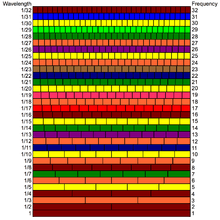Limit (music)

In music theory, limit or harmonic limit is a way of characterizing the harmony found in a piece or genre of music, or the harmonies that can be made using a particular scale. The term limit was introduced by Harry Partch,[1] who used it to give an upper bound on the complexity of harmony; hence the name. "Roughly speaking, the larger the limit number, the more harmonically complex and potentially dissonant will the intervals of the tuning be perceived."[2] "A scale belonging to a particular prime limit has a distinctive hue that makes it aurally distinguishable from scales with other limits."[3]
The harmonic series and the evolution of music

Harry Partch, Ivor Darreg, and Ralph David Hill are among the many microtonalists to suggest that music has been slowly evolving to employ higher and higher harmonics in its constructs (see emancipation of the dissonance). In medieval music, only chords made of octaves and perfect fifths (involving relationships among the first 3 harmonics) were considered consonant. In the West, triadic harmony arose (Contenance Angloise) around the time of the Renaissance, and triads quickly became the fundamental building blocks of Western music. The major and minor thirds of these triads invoke relationships among the first 5 harmonics.
Around the turn of the 20th century, tetrads debuted as fundamental building blocks in African-American music. In conventional music theory pedagogy, these seventh chords are usually explained as chains of major and minor thirds. However, they can also be explained as coming directly from harmonics greater than 5. For example, the dominant 7th chord in 12-ET approximates 4:5:6:7, while the major 7th chord approximates 8:10:12:15.
Odd-limit and prime-limit
In just intonation, intervals between pitches are drawn from the rational numbers. Since Partch, two distinct formulations of the limit concept have emerged: odd limit (generally preferred for the analysis of simultaneous intervals and chords) and prime limit (generally preferred for the analysis of scales). Odd limit and prime limit n do not include the same intervals even when n is an odd prime.
Odd limit
For a positive odd number n, the n-odd-limit contains all rational numbers such that the largest odd number that divides either the numerator or denominator is not greater than n.
In Genesis of a Music, Harry Partch considered just intonation rationals according to the size of their numerators and denominators, modulo octaves.[4] Since octaves correspond to factors of 2, the complexity of any interval may be measured simply by the largest odd factor in its ratio. Partch's theoretical prediction of the sensory dissonance of intervals (his "One-Footed Bride") are very similar to those of theorists including Hermann von Helmholtz, William Sethares, and Paul Erlich.[5]
See #Examples, below.
Identity
An identity is each of the odd numbers below and including the (odd) limit in a tuning. For example, the identities included in 5-limit tuning are 1, 3, and 5. Each odd number represents a new pitch in the harmonic series and may thus be considered an identity:
C C G C E G B C D E F G ... 1 2 3 4 5 6 7 8 9 10 11 12 ...
"The number 9, though not a prime, is nevertheless an identity in music, simply because it is an odd number".[6] Partch defines "identity" as "one of the correlatives, 'major' or 'minor', in a tonality; one of the odd-number ingredients, one or several or all of which act as a pole of tonality".[7]
Odentity and udentity are, "short for Over-Identity," and, "Under-Identity," respectively.[8] "An udentity is an identity of an utonality".[9]
Prime limit

For a prime number n, the n-prime-limit contains all rational numbers that can be factored using primes no greater than n. In other words, it is the set of rationals with numerator and denominator both n-smooth.
p-Limit Tuning. Given a prime number p, the subset of consisting of those rational numbers x whose prime factorization has the formwith forms a subgroup of (). ... We say that a scale or system of tuning uses p-limit tuning if all interval ratios between pitches lie in this subgroup.[10]
In the late 1970s, a new genre of music began to take shape on the West coast of the United States, known as the American gamelan school. Inspired by Indonesian gamelan, musicians in California and elsewhere began to build their own gamelan instruments, often tuning them in just intonation. The central figure of this movement was the American composer Lou Harrison. Unlike Partch, who often took scales directly from the harmonic series, the composers of the American Gamelan movement tended to draw scales from the just intonation lattice, in a manner like that used to construct Fokker periodicity blocks. Such scales often contain ratios with very large numbers, that are nevertheless related by simple intervals to other notes in the scale.
Examples
| ratio | interval | odd-limit | prime-limit | audio |
|---|---|---|---|---|
| 3/2 | perfect fifth | 3 | 3 | |
| 4/3 | perfect fourth | 3 | 3 | |
| 5/4 | major third | 5 | 5 | |
| 5/2 | major tenth | 5 | 5 | |
| 5/3 | major sixth | 5 | 5 | |
| 7/5 | lesser septimal tritone | 7 | 7 | |
| 10/7 | greater septimal tritone | 7 | 7 | |
| 9/8 | major second | 9 | 3 | |
| 27/16 | Pythagorean major sixth | 27 | 3 | |
| 81/64 | ditone | 81 | 3 | |
| 243/128 | Pythagorean major seventh | 243 | 3 | |
Beyond just intonation
In musical temperament, the simple ratios of just intonation are mapped to nearby irrational approximations. This operation, if successful, does not change the relative harmonic complexity of the different intervals, but it can complicate the use of the harmonic limit concept. Since some chords (such as the diminished seventh chord in 12-ET) have several valid tunings in just intonation, their harmonic limit may be ambiguous.
See also
- 3-limit (Pythagorean) tuning
- Five-limit tuning
- 7-limit tuning
- Numerary nexus
- Otonality and Utonality
- Tonality diamond
- Tonality flux
References
- ↑ Wolf, Daniel James (2003), "Alternative Tunings, Alternative Tonalities", Contemporary Music Review, Abingdon, UK: Routledge, 22 (1/2): 13
- ↑ Bart Hopkin, Musical Instrument Design: Practical Information for Instrument Design (Tucson, Ariz.: See Sharp Press. 1996), p. 160. ISBN 1-884365-08-6.
- ↑ Havryliv, M. and Narushima, T. (2006). "Metris: A Game Environment for Music Performance", Computer Music Modeling and Retrieval: Third International Symposium, CMMR 2005, Pisa, Italy, September 26–28, 2005, Revised Papers, p.105n3. Richard Kronland-Martinet, Thierry Voinier, Sølvi Ystad; eds. Springer Science & Business Media. ISBN 9783540340270.
- ↑ Harry Partch, Genesis of a Music: An Account of a Creative Work, Its Roots, and Its Fulfillments, second edition, enlarged (New York: Da Capo Press, 1974), p. 73. ISBN 0-306-71597-X; ISBN 0-306-80106-X (pbk reprint, 1979).
- ↑ Paul Erlich, "The Forms of Tonality: A Preview". Some Music Theory from Paul Erlich (2001), pp. 1–3 (Accessed 29 May 2010).
- ↑ Partch, Harry (1979). Genesis Of A Music: An Account Of A Creative Work, Its Roots, And Its Fulfillments, p.93. ISBN 0-306-80106-X.
- ↑ Partch (1979), p.71.
- ↑ Dunn, David, ed. (2000). Harry Partch: An Anthology of Critical Perspectives, p.28. ISBN 9789057550652.
- ↑ "Udentity". Tonalsoft. Retrieved 23 October 2013.
- ↑ David Wright, Mathematics and Music. Mathematical World 28. (Providence, R.I.: American Mathematical Society, 2009), p. 137. ISBN 0-8218-4873-9.
External links
- "Limits: Consonance Theory Explained", Glen Peterson's Musical Instruments and Tuning Systems.
- "Harmonic Limit", Xenharmonic.

